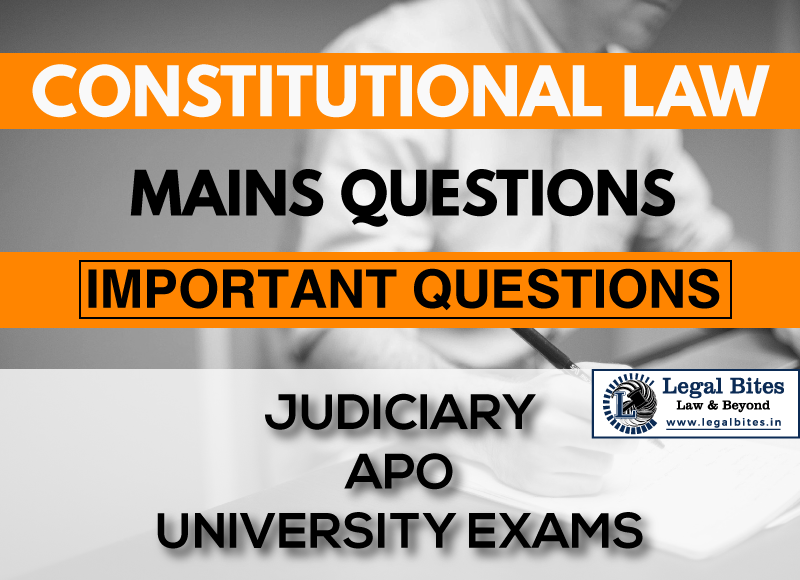“A” was convicted for the various terms of imprisonment in three cases under sections 380, 395, and 457 of the Indian Penal Code, 1960. Several similar cases were pending against him....Discuss the legal issues involved in the case.
Find the answer to the mains question of Constitutional Law only on Legal Bites.

Question: “A” was convicted for the various terms of imprisonment in three cases under sections 380, 395, and 457 of the Indian Penal Code, 1960. Several similar cases were pending against him. The Police published his photographs in public places, with a warning that he is a criminal who has to be taken care of. “A” challenges the publication of his photographs on various grounds. Discuss the legal issues involved in the case. [Punj JS 2006] Find the answer to the mains question...
Question: “A” was convicted for the various terms of imprisonment in three cases under sections 380, 395, and 457 of the Indian Penal Code, 1960. Several similar cases were pending against him. The Police published his photographs in public places, with a warning that he is a criminal who has to be taken care of. “A” challenges the publication of his photographs on various grounds. Discuss the legal issues involved in the case. [Punj JS 2006]
Find the answer to the mains question only on Legal Bites. [“A” was convicted for the various terms of imprisonment in three cases under sections 380, 395, and 457 of the Indian Penal Code, 1960. Several similar cases were pending against him. The Police published his photographs in public places, with a warning that he is a criminal who has to be taken care of. “A” challenges the publication of his photographs on various grounds. Discuss the legal issues involved in the case.]
Answer
The above proposition is similar to the case of Ayyappankutty v. The State (1987 CriLJ 1593), in which the state wanted to give warning to the possible group of victims against the dangers that they are likely to suffer at the hands of the petitioner if they are not careful. That is only what honest law enforcement demands and what is necessary for the interest of society. Police reasonably suspect that the Petitioner and his gang are habitually engaged in using force or even murdering taxi drivers for committing theft of taxi drivers. With these observations, it was held that by publishing photographs the police wanted to alert the taxi drivers that there was a man with whom they will have to be careful
The Petitioner requested before the court that the police and other state authorities may be restrained from publishing his photographs in public places. He claimed that this action of the police is illegal and violative of his fundamental rights. In view of his expectation of immediate release from jail, he feels that the publication of his photographs will adversely after his future life.
The question arises as to whether any of the fundamental rights or other common law rights of the petitioner is likely to be infringed by the publication of photographs in public places and if so, whether it will come within the reasonable restriction clause or state interest theory.
The present case is a conflict between State interest and freedom of life and liberty of the citizen as mentioned as a fundamental right under Article 21 of the Constitution. The Liberty of the individual is no more than what law gives him and it is also subject to reasonable restrictions on grounds of public interest, morality, decency, etc. as provided in Article 19 of the Constitution.
The court in this case held therein that publication of photos is evidently a preventive action which the police could resort to under the provision of Cr.P.C. Similarly, applying the arguments in the present case, it is to note that the fundamental right to liberty of the accused in Article 21 here is subject to the reasonable restrictions imposed by the state under Article 19 of the Constitution. Hence, A can’t challenge the publication of his photographs in public.
Important Mains Questions Series for Judiciary, APO & University Exams
- Constitutional Law Mains Questions Series Part-I
- Constitutional Law Mains Questions Series Part-I
- Constitutional Law Mains Questions Series Part-II
- Constitutional Law Mains Questions Series Part-IV
- Constitutional Law Mains Questions Series Part-V
- Constitutional Law Mains Questions Series Part-VI
- Constitutional Law Mains Questions Series Part-VII
- Constitutional Law Mains Questions Series Part-VIII
- Constitutional Law Mains Questions Series Part-IX
- Constitutional Law Mains Questions Series Part-X
Admin Legal Bites
Legal Bites Study Materials correspond to what is taught in law schools and what is tested in competitive exams. It pledges to offer a competitive advantage, prepare for tests, and save a lot of money.
